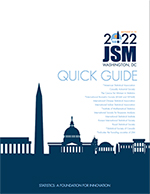Back
2022 Joint Statistical Meetings
Survey Research Methods Section
Session: Trends in Sample Design
Estimating the Size of Clustered Hidden Populations
Thursday, August 11, 2022
Activity Number: 526
-
Laura Gamble
Westat
Successive sampling population size estimation (SS-PSE) is a method used by government agencies and aid organizations around the world to estimate the size of hidden populations using data from respondent-driven sampling (RDS) surveys. SS-PSE addresses a specific need in estimation and helps us evaluate the vulnerability of areas to HIV and other epidemics by estimating the size of populations that are at higher risk of contracting and spreading HIV. However, SS-PSE relies on several assumptions, one of which requires the underlying social network of the hidden population to be fully connected. This research proposes two modifications to SS-PSE for estimating the size of hidden populations whose underlying social network is composed of disjoint clusters. The performance of these novel methods is then assessed using simulations.

